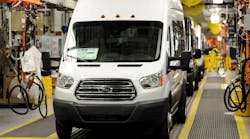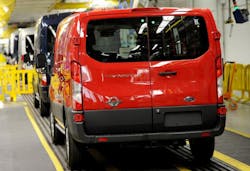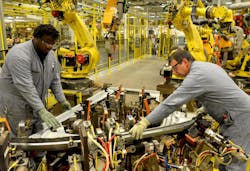Built by some 4,878 employees at its Kansas City, MO, assembly plant and boosted by some $1.1 billion in investments, Ford Motor Co. activated its new Transit van production line this week and plans to have the new full-size van ready for purchase this summer.
“Customers – especially commercial customers – want better fuel efficiency and more options from the vehicles they use today,” Joe Hinrichs, Ford’s executive VP and president of the Americas, told Fleet Owner by phone.
“The attractiveness of the Transit as the replacement for our best-selling E-Series van is its flexibility in terms of wheelbase configurations, roof heights, cubic space, and payload,” he explained. “Customers want a lot more options and that’s why the Transit is so important to our product mix; it gives those options to them.”
Hinrichs noted that E-Series vans and wagons still will be available and sold alongside the Transit into the 2014 calendar year, with the E-Series cutaway and stripped chassis continued to be built and sold through most of the rest of the decade.Ford originally introduced the Transit in the European market back in 1965 and today it is currently sold in 118 markets on six continents.
The OEM added that its new Transit van offers as much as 487 cubic feet of cargo volume and 4,650 pounds of maximum payload capacity, along with a maximum towing capacity of 7,600 pounds. In some configurations, Transit offers as much as much as 75% more cargo volume than the largest E-Series, Ford noted, with the Transit’s maximum payload offering 600 addition pounds across its model lineup compared to the E-Series.
Transit will be available in three body lengths, two wheelbases on van and wagon and three roof heights; in van, wagon, chassis cab and cutaway body styles, Ford noted, with two gasoline engine options – a 3.7-liter V6 engine and a 3.5-liter V6 EcoBoost model – along with a 3.2-liter Power Stroke diesel option. All three engines are being paired with a six-speed automatic transmission for efficient rear-wheel-drive operation, Hinrichs noted.
“Right now, gasoline remains the dominant fuel choice in this segment – our orders right now are running roughly 80% gasoline to 20% diesel,” he said. “We’ve also have the 3.7-liter V6 rated as a ‘Flex Fuel’ engine capable of operating on E85 [a fuel blend made up of 85% ethanol and 15% gasoline] as well as natural gas and propane prep package options. Again, this is to address the flexibility customers are demanding in terms of fuel choice for their operation.”
Ford noted it invested $1.1 billion to retool and expand the Kansas City facility not only for Transit production but to support what it called “surging customer demand” for its F-150 pickup.Expansion projects funded with that money at the plant include: the addition of a 437,000-square-foot stamping facility; a 78,000-square-foot paint shop that will employ the three-wet and two wet “mono-coat” paint processes; close to 550 new robots in the body shop; more than 700 new assembly tools in trim and chassis; plus 18 new conveyor systems totaling 5,565 feet.
Altogether, the Kansas City plant produces Regular, Super and Crew Cab versions of Ford F-150 along with the Transit, employing 4,878 hourly workers on three crews with the third crew added in the third quarter of 2013. The OEM added that Kansas City will also manufacture its brand-new 2015 model F-150 pickup starting next year, after the truck launches at Ford’s Dearborn Truck Plant in late 2014.
“These upgrades have helped make the Kansas City plant the global standard for Ford’s new manufacturing facilities across the world,” noted Bruce Hettle, Ford’s VP-North America manufacturing. “To support Ford’s global growth, in 2014 we will open three new manufacturing facilities – two of them in Asia Pacific and one in South America.”





